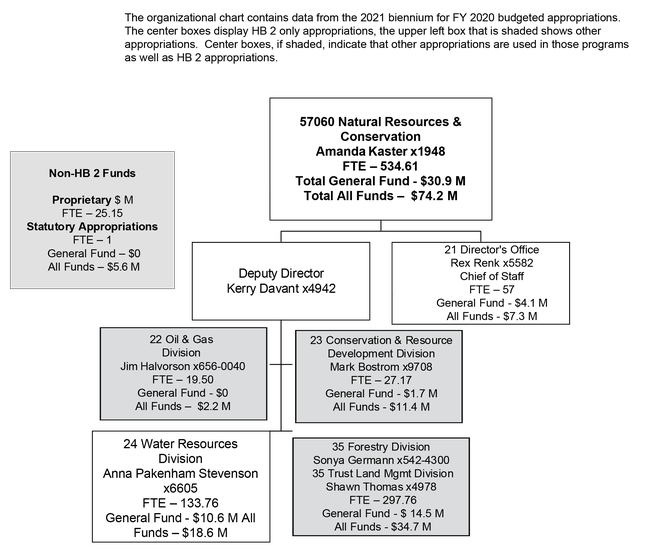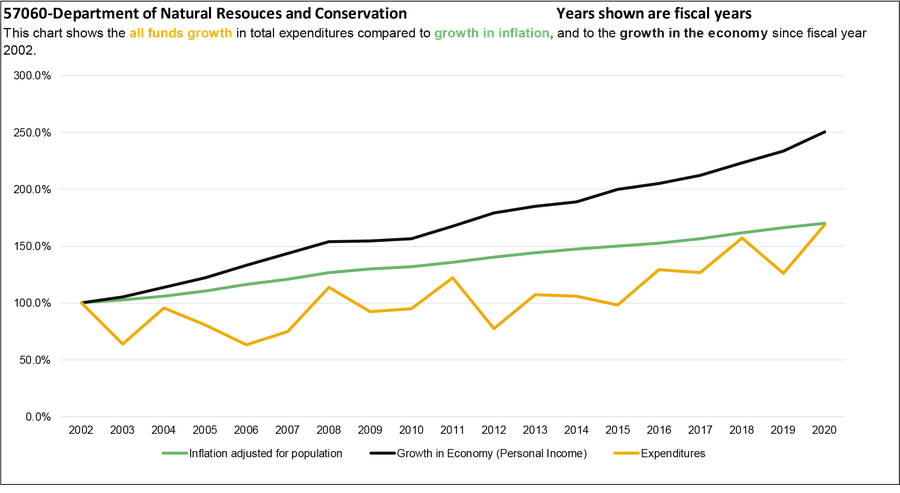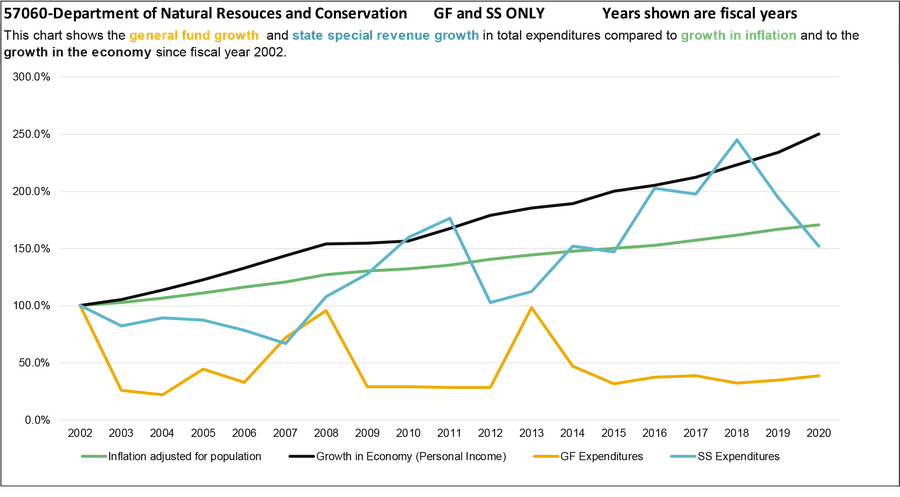Montana State Legislature
Department of Natural Resources & Conservation
The Department of Natural Resources and Conservation (DNRC) promotes the stewardship of the state’s natural resources, protects Montana from wildfire, and teaches about conservation. DNRC also supports the State Board of Land Commissioners, which controls the disposition of state trust lands.
Six divisions form DNRC with the following functions: o The Director’s Office provides managerial and administrative support services to the entire department o The Oil and Gas Conservation Division supports the Board of Oil and Gas, which issues drilling permits, classifies wells, administers bonds, plugs abandoned wells, and levies civil and criminal fines o The Conservation and Resource Development Division provides assistance to conservation districts and manages loan and grant programs The Water Resources Division administers programs associated with the uses, development, and conservation of Montana’s water including water rights, state water projects, water planning, dam safety, and floodplain programs o The Forestry Division is responsible for wildland fire suppression, wildland fire prevention, and the implementation of statewide forestry assistance programs. o The Trust Land Management Division manages of trust lands granted to the State of Montana
Below is an organizational chart of the branch, including full-time employee (FTE) numbers and the HB 2 base general fund appropriations and the total of all funds. Unless otherwise noted, all phone extensions are preceded by (406) 444.


This report includes a series of charts that compare expenditure growth to the growth in the economy and growth in inflation adjusted for population. Montana statute, 17-8-106, MCA, recommends using growth in personal income for comparison purposes. Personal income is a measure for growth in the economy. Comparing growth allows financial planners to consider past and future demands in services or changes in revenues.
As of publication date, non-budgeted transfers for FY 2021 have not been included in SABHRS data and therefore do not adequately represent costs, as a result, FY 2021 has not been included in the chart.
In FY 2002 the agency expended one-time-only funding of $46.4 million to acquire mineral rights on state lands. Increases in expenditures in FY 2004, FY 2007, FY2008, and FY 2018 were for fire suppression. Higher expenditures in FY 2016 and FY 2017 were from the state revolving fund for renewable resource projects.

As of publication date, non-budgeted transfers for FY 2021 have not been included in SABHRS data and therefore do not adequately represent costs, as a result, FY 2021 has not been included in the chart.
General fund
Expenditures for fire suppression from the executive’s emergency appropriations and supplemental appropriations account for the increased general fund expenditures in FY 2008 and FY 2013. In FY 2002 there was one Non-Budgeted expenditure of $46.4 million for the purchase of mineral rights on school trust lands, this was a loan from the coal severance permanent fund. In recent years non-budgeted expenditures have been relatively small. Excluding FY 2002, expenditures from HB 2 authority have grown at an annual rate of 1.7% per year.
State Special Revenue
Annual growth in state special revenue during the period was 4.0% compared to the rate of inflation of 2.1% per year over the period. State special revenue supported 79.3% of total expenditures in FY 2018 compared to 69.1% in FY 2002. Increase in state special resource expenditures in FY 2010 and FY 2011 are non-budgeted for water and waste water projects throughout the state. In FY 2018 $65.9 million was expended for fire suppression in the summer of calendar year 2017.
Legislative Changes
2019 Session
- HB 3 transferred $21.5 million from the general fund and $15.0 million from the private correctional facility contract renegotiation account to the fire suppression fund.
- HB 34 provides the Department of Natural Resources and Conservation with a statutory appropriation as revenues are received to expend federal revenues generated from the Good Neighbor Authority.
- HB 10 appropriates $5.4 million in general fund and state special revenue to fund two information technology systems, the Water Rights Information System and Trust Land Management System II.
- HB 411 appropriates $650,000 invasive species state special revenue to the agency to support 2.00 FTE to staff advisory on invasive species council and to administer grants in accordance with 80-7-1018, MCA.
2015 Session
- SB 261 authorized DNRC to preserve the greater sage grouse including the appropriation of $10 million to maintain, enhance, restore, or expand sage grouse habitat
- SB 262 ratified the water compact with Confederated Salish and Kootenai Tribes
2013 Session
- HB 354 provided for transfers from the general fund and the corporation tax to the wildfire suppression account. The legislation limited the fund balance in the account to a maximum of $100 million and provided for the account to be statutorily appropriated
2011 Session
- HB 49 authorized the sale of bonds to fund the Blackfeet water compact. DNRC was authorized to issue and sell $16.0 million in general obligation bonds to pay the state's costs for water-related infrastructure projects within the Blackfeet Indian reservation
- SB 35 clarified state laws related to the beds of navigable rivers and defined a "navigable river." It provides rulemaking authority to the Board of Land Commissioners to provide for leases, license, or easements to use the beds of navigable rivers and requires authorizations from the Board of Land Commissioners to use the beds of navigable rivers
2009 Session
- HB 645 provided $35.0 million in funding for development of wastewater and drinking water infrastructure, state and private forestry activities, and funds for the Blackfeet and Fort Belknap water compacts
- 2007 Session
- HB 3 in the 2007 special session provided for the creation of a fire suppression account, transferred $40 million general fund to the account, and statutorily appropriated the funds in the account for fire suppression activities beginning in FY 2009
- HB 19 prohibited diversions of Morrill Act Land revenues for administrative costs and provides a statutory appropriation of $80,000 general fund each biennium to administer the trust
- HB 473 provided for a $25.0 million transfer from the general fund to the state special revenue fund for water adjudication activities. This legislation eliminated the water adjudication fee passed by the 2005 Legislature
Click the double-sided arrow in the lower right corner of the image below to enlarge the graphic. Then, click the box next to the agency you want to see. To minimize, click Esc.
Legislative Studies
Environmental Quality Council interim work
Audit Reports
Financial Compliance Audit - DNRC - Nov 2018
Legislation
See the Legislation tab on the Environmental Quality Council web page
SB 136, Clarify criteria for permits and water right changes
HJ 6, Study of natural resources trust fund
HB 352, Revise laws related to conservation easements
HB 373, Revise natural resources operations fund, provide transfer
HB 374, Amend coal severance tax SSR accounts, provide transfers
HB 594, Exempt DNRC grants from environmental review
HB 607, Revising energy generation laws and renewable requirements
SB 326, Provide for irrigation district improvements by resolution
SB 352, Clarify objections to water rights
SB 371, Repeal CSKT water rights compact
HB 498, Jurisdiction of board of oil and gas
HB 518, Revise flood plain delineation, review and regulations
SB 249, Revise funding for the Montana greater sage grouse stewardship act
SB 260, Revise related to property interests and transfer of business
SB 302, Extend authorization deadline for use of navigable riverbed
SB 304, Revise establishment of stock water rights on federal lands
Gov. Gianforte 2023 Biennium Budget - Department of Natural Resources & Conservation
2023 Biennium Executive Summary - Department of Natural Resources & Conservation
Agency profile information provided by the Legislative Fiscal Division.
